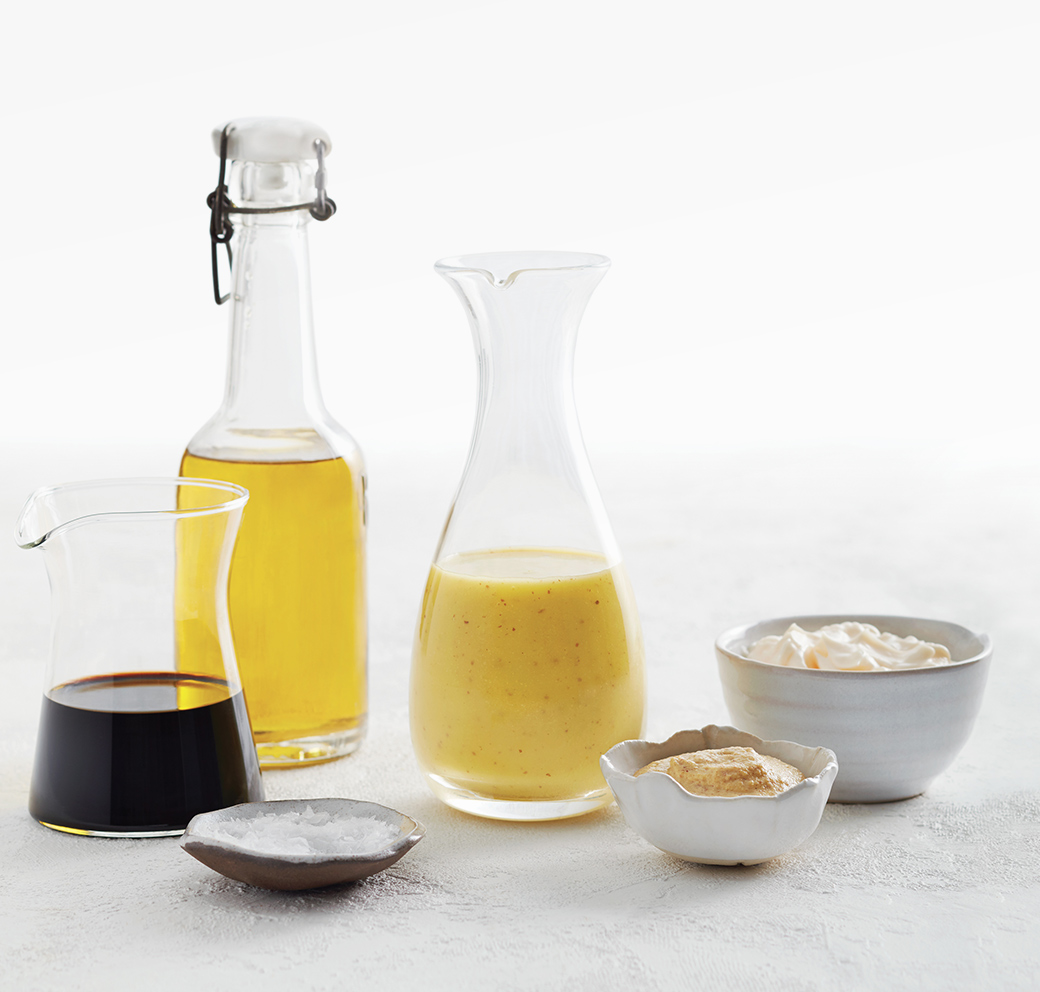Salad Dressing Basics
A salad dressing is a combination of oil, vinegar, an emulsifier and optional herbs and spices. It is sometimes referred to as a vinaigrette. Here's are the basics on what to include, how to make it plus serving tips.

Acid
Vinegar gives spirit and tang to the dressing. Use white wine vinegar for a more mellow taste, red wine vinegar for a rosier colour, rice wine which is milder, or apple cider when there is fruit in the dressing. Balsamic is mellower and slightly sweeter, sherry vinegar is softer and more rounded. Fresh lemon juice adds lots of zing.

Fat
Oil carries the flavour of the salad dressing. Use olive oil (preferably extra virgin) which has a richer flavour. When you want a less assertive flavour, use safflower, sunflower, peanut, canola or avocado oil. Nut oils add a flavour change.

Salt
It is the great leveller of salad dressings. When the dressing tastes too oily, add salt. The oiliness will be gone. Use kosher salt for a better flavour and for a special treat finish the tossed salad with a sprinkle of finishing salt such as Maldon.

Emulsifier
Mustard or Mayonnaise work as an emulsifier, as oil and vinegar will not combine without one of these. Dijon mustard is the best emulsifier, adding tang. Mayonnaise works too and will make a creamier dressing.
Salad Dressing Recipe
Homemade dressing tastes better and is healthier and cheaper than store-bought dressing. This recipe also makes for a wonderful marinade for a steak or lamb chops. Make the it in a larger quantity and store in a jar in the refrigerator. Shake to re-emulsify it just before using. This recipe calls for white wine vinegar but substitute others, if you wish.
¼ cup (60 mL) white-wine vinegar
1 tbsp (15 mL) Dijon mustard
¾ cup (175 mL) extra-virgin olive oil
Salt and freshly ground pepper, to taste
Whiskvinegar and mustard together using a stick blender or by hand. Slowly pour in oil, whisking as you go. If you pour the oil too quickly, it will not be absorbed. Season well with salt and pepper.
Makes about 1 cup (250 mL)
Salad Tips

Make-Ahead Big-Batch
Make a large batch of basic dressing for the week. Dressings last at least three weeks, refrigerated. Remember to take it out of the refrigerator half an hour before using. Oil solidifies in the refrigerator.

Preparation Trick
A stick blender takes the whisking work out of salad dressings if you make a larger batch.

Greens
Don’t use salad mixes, create your own. Buy and wash a mixture of lettuces then store wrapped in paper towels in a plastic bag in the refrigerator. The lettuce lasts a week and it is much more flavourful.

Suggested Salad Ratio
If you put about 3 tbsp (45 mL) dressing in the bottom of a bowl (for 4 people) then add about 6 cups greens (1.5 L) you get a better distribution of the dressing and, as a bonus, you use less.
Add Ins

Texture
Seeds, nuts, dried fruit, toasted grains, toasted bread crumbs, crumbled taco chips

Cheese
Ricotta, feta, grated Parmesan, mozzarella, blue cheese, Comte, smoked cheese

Fruit
Pears, apples, strawberries, mangoes, grapes (especially roasted)

Flavour
Herbs, spices, garlic, ginger, olives, pickles, honey, sugar or maple syrup
Switch It Up
To make a Caesar dressing out of a basic dressing add a squeeze of lemon juice, ½ tsp (2 mL finely chopped garlic, 1 tsp (5 mL) Worcestershire sauce, 1 tsp (5 mL) chopped anchovies and ¼ cup (60 mL) grated Parmesan. Whisk together.



